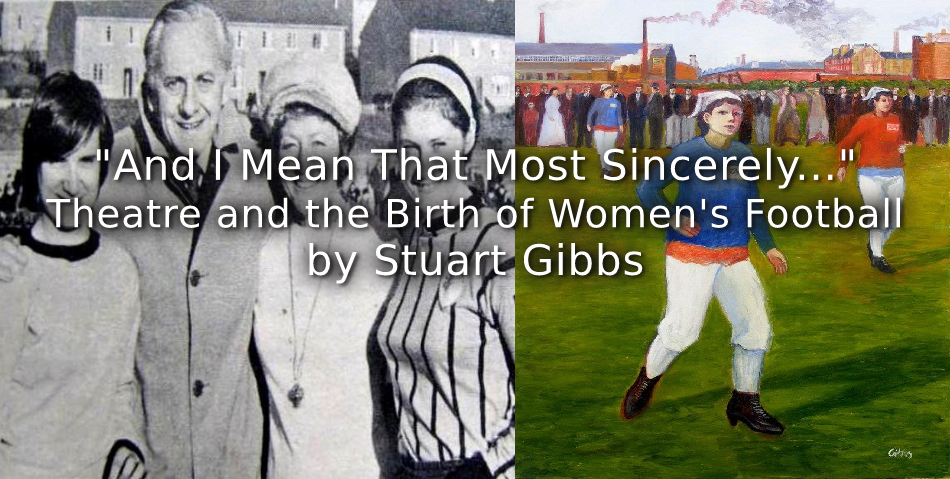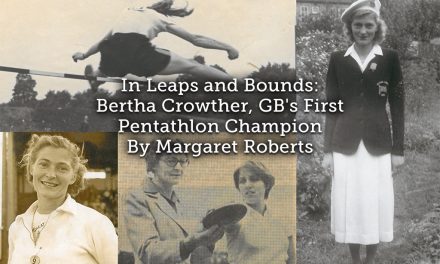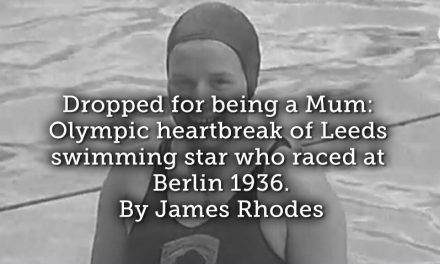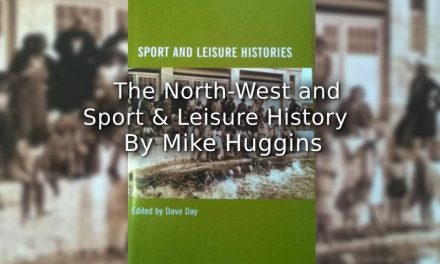It is well known that women’s football is not a modern invention. The first reference to women kicking a ball is in 1629 from the church records of Carstairs in Lanarkshire.1 Matches were also recorded such as the six-a-side game played on Bath bowling green in 1726 and the encounter between Coldstream and Lennel in 1786.2 Women’s association football first took place in 1881 when a group of theatre entrepreneurs organised a tour. The group consisted of Edinburgh born Alec Gordon, Charles Scholes of Blackburn and George Imbert born in Bethnal Green, London. Imbert, under the name George Frederick Charles, was manager of the St Helens Theatre Royal part of a theatre chain run by Charles Scholes. In 1880 Scholes’ theatre chain collapsed with debts of around £2,500. In a bid to raise money a scheme inspired by the success of the Scotland vs. England men’s internationals to tour women’s football sides was hatched. Glasgow, as the foremost centre for football, was chosen to host the matches and ahead of the sides debut. Studies of the published team line ups show that the players also had theatrical connections.
Scotland; Ethal Hay, goal; Bella Osborne, Georgina Wright, backs; Rose Raynham, Isa Stevenson, half backs; Emma Wright, Louisa Cole, Lily St Claire, Maud Rimaford, Carrie Baliol, Maud Hopewell and Minnie Brymner, forwards.
England; Mary Goodwin, goal; Mabel Hopewell, Maud Starling, backs; Ada Everstone, Geraldine Vintner, half backs; Mabel Vance, Kate Mellor, Eva Davenport, Minnie Hopewell and Nellie Sherwood, forwards.3
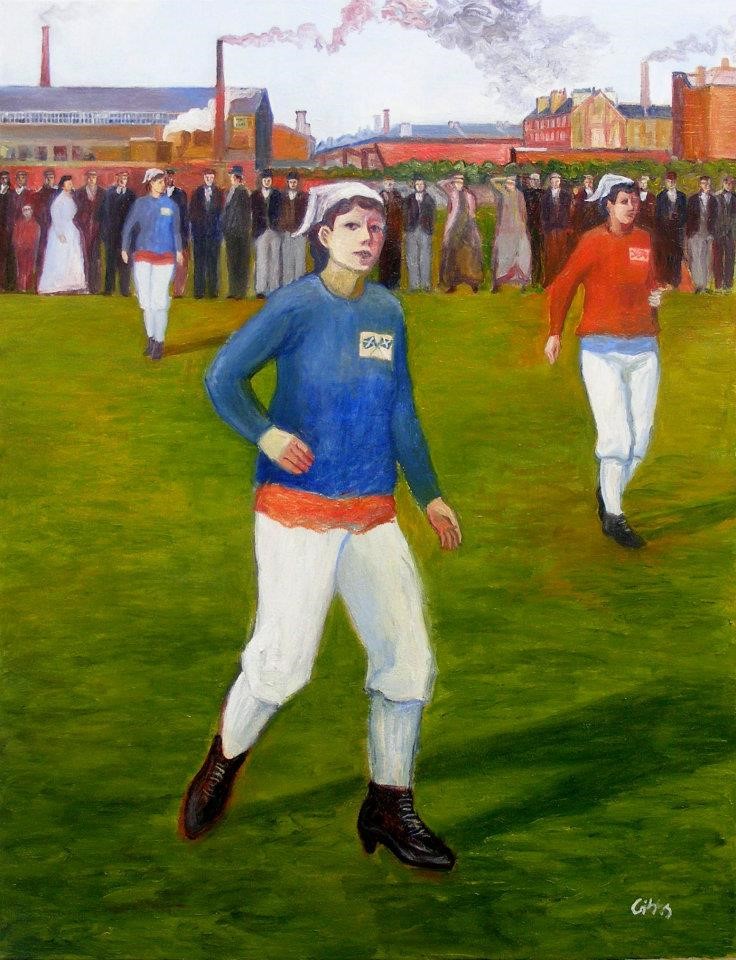
Lily St Claire first recorded goal scorer in women’s football
She is likely to have been the stage actress, Lillian Davis.
Jane Roberts, a local history researcher uncovered squad members Carrie Baliol and Louisa Cole from the 1881 census, with both listed as ‘actors’.4 Further investigations revealed that Baliol was born in Newcastle in 1862 as Ann Caroline Baliol but despite this she appears for ‘Scotland’.5 If she was a long time resident and developed an accent this could be easily explained. Louisa Cole, was born Constance Louisa Cooper Hodgson in Greenock in 1863 and was brought up in Barony Parish (now North Glasgow).6She appeared on stage along with her partner James Cole, as a double act, ‘Jim & Louisa Cole’. Other players were attracted to the tour by word of mouth or through the organiser’s own contacts. The Irvine Times, noted that many in the squad were ballerinas and the prominent organiser of dance at the time, the Nottingham based Eliza Savage, was in Glasgow just as the football side was being organised. Savage toured under the name Lizzie Gilbert’s Juvenile Ballet Troupe and during the early months of 1881 the troupe had joined the cast of Charles Bernard’s touring youth production, Les Cloche de Corneville.7
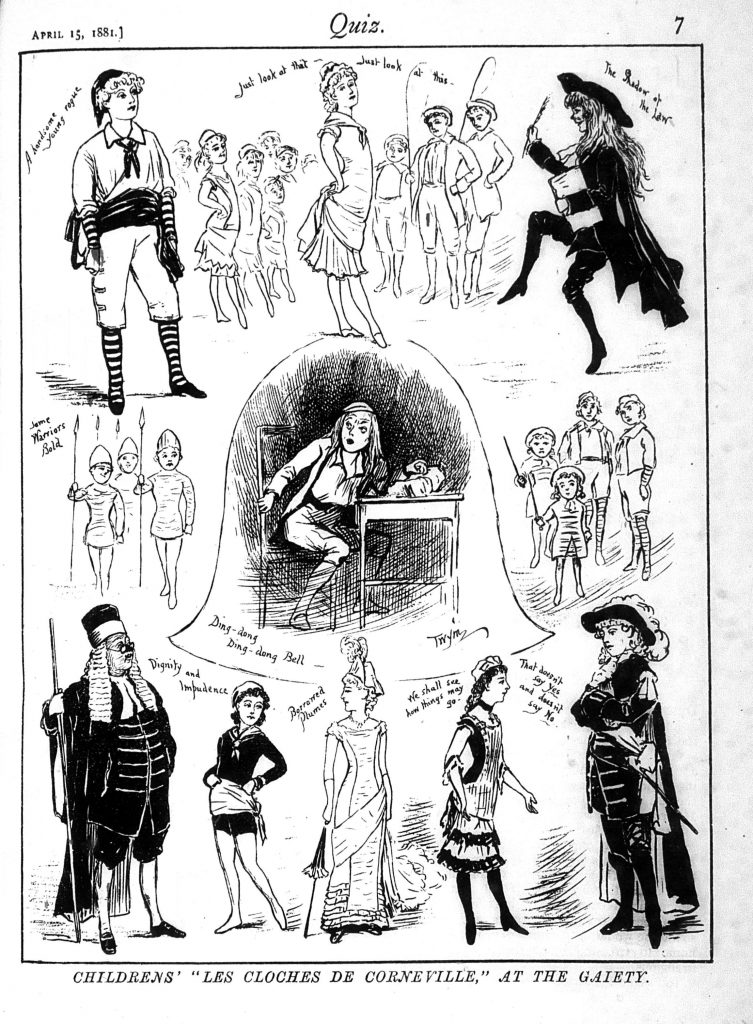
An illustration for Charles Bernard’s youth production of Les Cloches de Corneville
Performers surplus to requirement appeared in the debut of the Lady Players football match in Edinburgh
One feature of Eliza Savage’s ensemble was Miss St Claire, who besides dance also had her own signing spot and may have been the Lily St Claire listed in the Scotland side. This calls into question the claim that the sides were organised to their bona fide nationality as Eliza Savage’s troupe, consisted mostly, of the poor and disadvantaged of Nottingham. The 1881 census taken on April 3rd lists Savage and her charges in a Middlesbrough guest house during the Les Cloche de Corneville tour. Most of the entries hailed from Nottingham, with one exception Lillian Davis. She was recorded as born in Scotland but like Carrie Baliol there are no specific details. It does seem highly likely, however, that she was Lily St Claire.8Another interesting feature of the 1881 census was that ages listed varied from 6 to 10, 11 and 13 years and a report on the debut match noted that the ‘ages ranged from about 12 to 16 or 17 years’.9
Les Cloche de Corneville arrived in Glasgow on 11 April 1881 for an extended run at Bernard’s Gaiety Theatre. Gordon and Imbert were able to take performers, surplus to requirements, for their football tour and they were trained at a drill hall on what is now Parnie Street. The Cloche de Cornville Company had their own sports, a cricket club, in which the shows star Cecil Barth captained, with tennis and football also played. It is possible that the intake from Cloche de Cornville had already played football ahead of the tour.10After great difficulty finding a venue in Glasgow, Hibernian’s original ground at Easter Road in Edinburgh was established for the first women’s association football match. Lillian Davis playing under the name Lily St Claire opened the scoring with Louisa Cole adding the second in the 3-0 win.
A second match held in Rutherglen at the Shawfield athletics ground was abandoned in the second half after the ground was invaded by rioters. A court order the following day annulled the company’s performance licence to appear at a subsequent fixture in Kilmarnock. As a result the party returned south where a match was organised a few days later at Blackburn Olympics ground, the first women’s association match in England. Further matches were held in Pudsey, Sheffield and Liverpool with further riots at matches in Manchester. The party however generated the desired revenue from the venture.
Both Alec Gordon and George Imbert took up leases on new theatres in Dublin and St Helens while George Imbert was able to redevelop the Blackburn and Bolton Theatre Royals. Many of the players returned to their old life on stage. Lillian Davis had a prominent stage career in the late 1880s and early 1890s yet little known about her. In 1885 Constance Hodgson had a child named Louisa Cole but she separated with James Cole soon afterwards. In 1890 she married Clarence Smythson and would later tour as the ‘The Smythsons’. Constance died in Barnet in 1943.11In 1881 the prospects for women’s football were not considered great, and writing on the debut match in Edinburgh, one paper noted.
‘The general feeling seemed to be that the whole affair was a most unfeminine exhibition, and it should certainly be rash to predict, from Saturday’s experiment, that “ladies football matches” will become popular in Scotland’.12
The revenue generated by women’s matches did not go unnoticed, however, and more fixtures were staged the following year. With the exception of a return visit to Sheffield’s Queen’s Hotel Grounds on April 26th 1882 these matches received little coverage. In Grimsby, during the mid 1880s, a new consortium consisting of George Soule, Peter Bridges and a circus performer Albert Wells, formed their own side. One fixture, was recounted by the St James Gazette in November 1885, the venue isn’t specified but may have been the women’s match played at the second Hampden Park during the late autumn of 1884.13In the 1890s teams associated with Dillon’s Gymnastics Group or Carls’ Association formed even the British Ladies Club had links to the stage. In the early 20th century women’s matches were organised by the well-known music hall stars such as, Florrie Ford, Fred Lumley and Harry Weldon. But the formula devised for the 1881 matches, the touring side with resident opposition, continued into the 1960s.
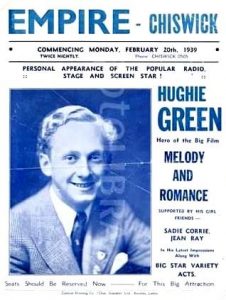
Publicity poster for Hughie Green
In 1938 he organised a girl’s vs. boys football match as a promotion for his touring ‘Stars of Tomorrow’ cabaret.
Another stage figure to get involved with women’s football was Hughie Green. As a youth star in the 1930s he had his own juvenile variety troupe Hughie Green’s Gang and as publicity for his ‘Stars of Tomorrow’ tour he captained a boy’s side against the girls. One match played at Southend in December 1938 was filmed for Pathe News14Green’s career saw him make more conventional film appearances in Melody and Romance and Midshipman Easy, but by the mid-1960s he had washed up on television and his Stars of Tomorrow act had become Opportunity Knocks. It was during the talent shows 1967 run that the idea for a women’s tournament came about, after a quiet chat with a lady sponsor from Scotland. The idea was developed into an event which involved regional competitions hosted by Butlin’s holiday resort chain with a grand final to be held in London.15
Neil Morrison is among the small group of researchers investigating the Butlins tournament. Much of the Butlins Cup went unreported but enough records remain to put together a reasonable account of the event. The Cheshire club Foden progressed in the regional competition beating Ramar Ladies in the Zone final, the Wanderers in the Inter Zone final and Southampton by 5-1 in the English final. Butlin’s Heads of Ayr camp hosted the Scottish competition which attracted teams such as Bowden Ladies from Fife and Forth Valley Bluebirds from Stirling but the tournament came down to clash between the top two sides Stewarton Thistle and Westthorn Utd. Hughie Green flew over from Amsterdam for the final but with Thistle’s star player Rose Reilly sidelined, Westthorn won a rather one sided match, 5-1.16
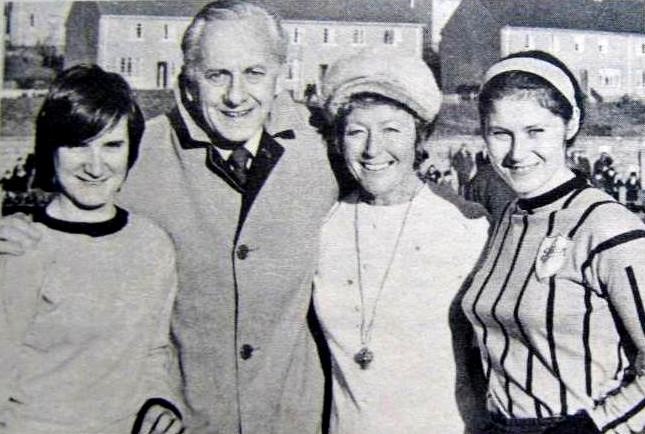
Hughie Green with Westthorn captain Mary Davenport and Shelia Parker captain of Foden
Taken prior to the Butlins Cup replay at Greenock’s Ravenscraig Stadium in 1969.
The grand final between Westthorn and Foden held at the Willesden Sports Ground in North London ended 0-0 after extra time but as the tournament reached it conclusion a new body to administer women’s football was in the process of forming. Arthur Hobbs a council worker from Kent had established the Deal International Tournament with the intention of developing women’s football as a serious well respected sport. There were now two competing visions of how the game could progress. After the drawn Butlins final, Green assessed the viability of Greenock’s Ravenscraig Stadium as a suitable venue for the replay. Later that day he visited town’s Odeon Cinema about to close its doors for the last time. He spoke to the staff about the venue’s heyday as the Kings Theatre. ‘It was one of the best music halls in Scotland. I recollect talking to film actor Cary Grant, who loved talking about his days at the Kings in Greenock’, Green told a bemused assistant manager. 17
At London’s Caxton Hall on November 1st 1969 club representatives from across the UK gathered for the inaugural meeting of the Women’s Football Association. The main aim of the new body was to give women’s football sporting integrity. An incident during the Butlins final generated a great deal of discussion. An altercation with Jean Ramsay during the match resulted in Joan Tench having her shorts round her ankles. Photographs of Tench’s garment malfunction appeared not only in the national press but also overseas, this was not what the WFA were looking for. A few days later the Butlins Cup replay took place at the Ravenscraig Stadium with, ironically enough, Joan Tench scoring the only goal in a tightly contested game.18
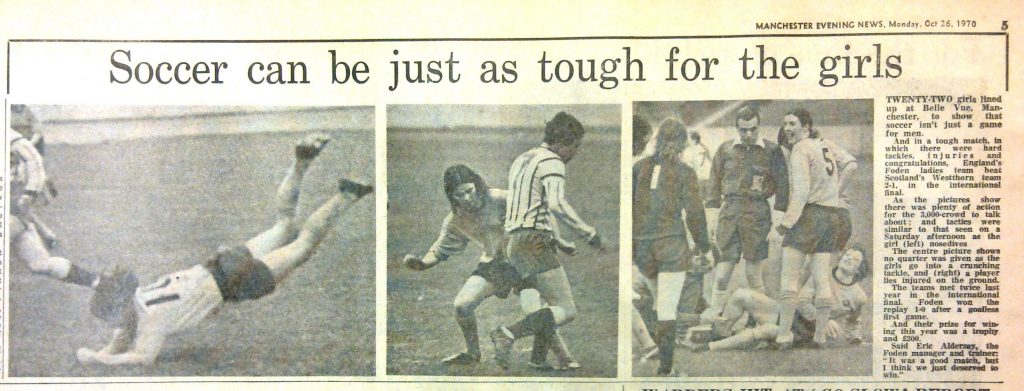
The 1970 Butlins final was staged at Manchester’s Belle Vue stadium
This was the last time the tournament was held being replaced the following year by the WFA’s Mitre Trophy.
A second Butlins Cup took place during the summer of 1970 under the threat of sanctions by the WFA and Foden, Thame Ladies and Westthorn Utd were among the few big names to take part. The final played at Manchester’s Belle Vue stadium was a repeat of the pervious year with Foden managing to grind out a 2-1 win against Westthorn.19 The WFA, however, were organising their own competition for the 1970/71 season. Titled the British Isles, Mitre Trophy, it involved a series of regional competitions with semi finals and a grand final to be held in London. Both tournaments were similar in nature and with the prospect of these events competing for participants, the Butlins Cup was discontinued. It was more than a competition that that had concluded, the long association between women’s football and the theatre had come to an end. The game developed into the modern sport we know today, and while many have argued that it hasn’t progressed as much as it could have, one thing is clear, women’s football has moved onto a larger stage.
Article © of Stuart Gibbs
References
1 Stuart Spencer, “Kirk Minister Complaint Confirms 390th Anniversary of Women’s Football in Europe”, Scottish Football Museum, 21 August, 2018
2 Margaret Makepeace, “Women’s football in the 18th Century”, Untold Lives Blog, British Library, 17 June, 2021.
3 “Athletic Jottings”, Glasgow Evening News & Star, 7 May, 1881, 4
4 Jane Roberts, “Pioneers of the FIFA Women’s World Cup, The First Football Internationals”, Past to Present Genealogy, June 12, 2019.
5 1871 England & Wales Census, Elswick, Newcastle upon Tyne, digital image, s.v. “Ann Caroline Baliol”, Ancestry.com.
6 1871 Scotland Census, Barony Parish, Blythswood, s.v. “Constance Hodgson”, Ancestry.com.
7 “The Lady Football Players”, Irvine Times, 21 May 1881, 5
8 1881 England & Wales Census, Middlesbrough, St Johns, digital image, s.v. “Eliza Savage”, Ancestry.com.
9 “Lady Footballers”, Edinburgh Courant, 7 May 1881, 4
10 “Athletic Jottings”, Glasgow Evening News & Star, 16 April, 1881, 3
11 England & Wales Civil Death Registration, Death Index, 1916-2007, digital image, s.v. “Constance L C Smythson”, Ancestry.com.
12 “Ladies Football Matches in Scotland,” Civil & Military Gazette, 17 June 1881, 6
13 “Lady Footballers in Stockport”, Stockport Advertiser, 7 May, 1920, 5
14 “Men & Women Football Match at Southend Lner”, British Pathé News, issued 27 March, 1938, https://www.britishpathe.com/video/men-and-women-football-match-at-southend-lner/query/Hughie
15 Butlins Cup final Programme, London, Mirror Group, 19 October, 1969
16 “Ladies Soccer Final,” Ayr Advertiser, 4 September, 1969, 19
17 “Hughie Green at the Last Odeon Show,” Greenock Telegraph, 27 October 1969, 7
18 “Girls Charm Large Ravenscraig Crowd,” Greenock Telegraph, 11 November 1969, 5

